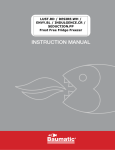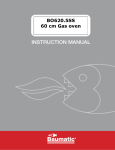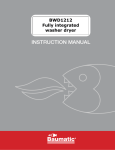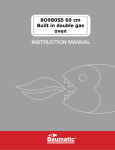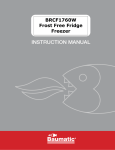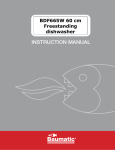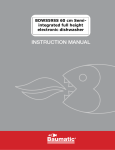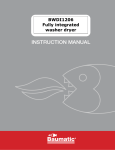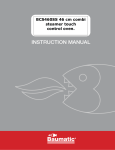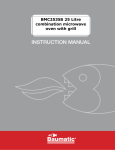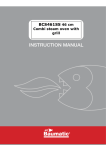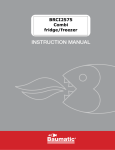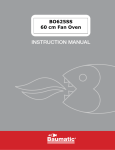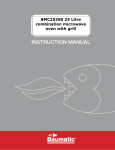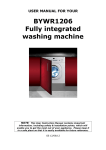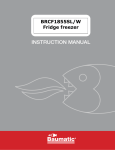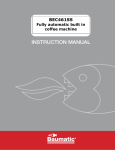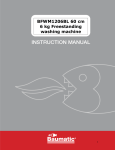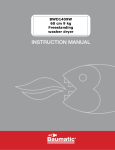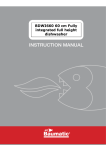Download BWM1417W 60 cm 7 kg Washing Machine
Transcript
BWM1417W 60 cm 7 kg Washing Machine 1 USER MANUAL FOR YOUR BAUMATIC BWM1417W 60 cm 7 kg Washing machine NOTE: This User Instruction Manual contains important information, including safety & installation points, which will enable you to get the most out of your appliance. Please keep it in a safe place so that it is easily available for future reference; for you or any person not familiar with the operation of the appliance. GS 25/01/12 2 Contents Environmental note 4 Important safety information 5–6 Specifications 7-8 Description of the appliance Control panel LCD display Detergent drawer 8 9 - 10 10 - 11 11 - 12 Preparing the wash cycle Preparing your garments for washing A selection of wash care symbols Detergents and conditioners Wash program table 12 - 16 12 13 13 – 14 14 – 16 Wash program guidance 16 - 17 Selecting a wash program End of cycle Adding a garment Manual soaking Delay start feature Child lock Power off memory 17 - 19 17 - 18 18 18 18 - 19 19 19 Maintenance and cleaning In daily use Control panel and washing machine cabinet Detergent drawer The washing machine drum Door Cleaning the drain pump filter Cleaning the water inlet filter Winter storage Removing stains Stain removal rules Stain removal guide Poor wash results 19 - 25 19 20 20 20 – 21 21 21 22 22 23 23 23 - 24 25 Installation Washing machine accessories Removing the transit bolts Locating your washing machine Adjusting the height of the appliance Connecting to the mains water supply Connecting to the water outlet Power supply Before first use maintenance wash 26 – 32 26 26 - 27 27 28 29 30 - 31 32 32 Error code failure system General troubleshooting Baumatic consumables Technical data 33 34 – 35 36 37 Contact details 38 3 Environmental note 4 Important safety information Your safety is of the utmost importance to Baumatic. Please make sure that you read this instruction booklet before attempting to install or use the appliance. If you are unsure of any of the information contained in this booklet, please contact the Baumatic Advice Line. General Safety o Repairs to your appliance must only be carried out by a Baumatic engineer or one of its authorised service agents. Any attempt by an inexperienced person to repair the appliance, could result in injury or damage to your washing machine. o If you notice that the mains cable is damaged. The appliance must not be used. The same applies if you notice that the worktop, control panel or base area is damaged. As this could allow access to the internal components of the machine. o The appliance should be turned off and isolated from the mains supply, before either cleaning or maintenance work is attempted. o The mains cable must not be used to pull the plug out of the electrical socket. o The machine should not be sprayed with water. o The glass of the porthole door may become hot during the higher temperature wash programs. o The machine should be allowed to cool before carrying out an emergency drain or cleaning the drain filter. o It is possible for small animals to chew either the mains cable or water hoses, which could cause an electric shock hazard. Installation o The installation instructions contained within this user manual should be followed. o It is obligatory for the completed installation to comply with all relevant building regulations and local water authority requirements. 5 o Before the first use of the appliance, we advise that a 95 degree self-clean cycle is completed. No garments should be placed inside the machine; however a small amount of detergent must be used. During Use o It is recommended that the appliance is unplugged and the water supply is turned off after the machine is used. o This appliance is only designed to wash normal domestic wash loads. If you use your washing machine in any other way or it is incorrectly used, then Baumatic accepts no liability for any damage that might be caused and any guarantee will be void. o No attempt should be made to alter or modify the specifications of this appliance. o The detergents that you place in this appliance should be suitable for automatic washing machines. With regards to dosage levels, the detergent manufacturer’s recommendations should be followed. o You should not wash garments that have been in contact with flammable materials. o Your washing machine should not be used for dry cleaning. o If you use either dyes or bleaching agents inside this machine, then you should consult with the manufacturer of these products to make sure they are suitable for use in your washing machine. Baumatic cannot be held responsible for any damage that may result. Child Safety o Your washing machine should only be used by adults. You should not allow children in the area of the machine unsupervised. You should not let them touch the controls or play with the appliance. o It could be possible for a child or pet to gain access to the washing machine through the porthole door. Therefore please check the drum before using the appliance. o Any packaging that is removed from the machine should be kept away from children. o All detergents should be kept out of a child’s reach and in a safe place. 6 Specifications o 15 program options o 7 kg wash load o 1400 rpm maximum spin speed o o o o o o o o o o o o o o o Variable spin speed LED display Digital countdown indicator Delay start Wash temperature control Anti-crease function Safety lock Failure detection system Imbalance control system Overflow protection Foam protection 54 litre drum size 300 mm porthole diameter 180° door opening Adjustable feet Appliance dimensions Height: Width : Depth: 855 mm 595 mm 565 mm 7 Ratings Energy efficiency class Wash performance class Water extraction performance class A A B For future reference please record the following information which can be found on the rating plate and the date of purchase which can be found on your sales invoice. The rating plate for your washing machine will either be located on the right hand side of the cabinet or behind the porthole door. Model Number ………………………………. Serial Number ………………………………. Date of Purchase ………………………………. Description of the appliance 8 Control panel 1) Program selection dial. This dial can be rotated to select the appropriate wash program for your wash load. 2) Start/pause button. This button can be pressed to start a wash program and again to temporarily pause the cycle. 3) Extra function button. You can select either or both of the extra wash functions, extra rinse or pre-wash, by pressing this button. 4) Add garment button. When this button is pushed, the wash program will pause to allow more clothes to be added. 9 5) Water level selection button. You can adjust the water level for the washing and rinsing programs according to the amount of laundry. Press the button repeatedly to choose from the following options: Tiny Æ Low Æ Mid Æ High 6) Water temperature selection button. This button can be used to adjust the washing temperature. Press the button repeatedly to select from the following options: 30°C Æ 40°C Æ 60°C Æ 95°C 7) Spin speed selection button. This button can be used to adjust the spin speed of the cycle. Press the button repeatedly to select from the following options: No Spin Æ 600rpm Æ 800/900rpm Æ 1000/1400rpm 8) Delay start button. This button is used to program a delayed start to the cycle. See the “Delay start” section of this manual. LCD display A) Water level display. These LEDs indicate the water level set for the wash cycle. B) Temperature display. These LEDs indicate the water temperature set for the wash cycle. C) Spin speed display. These LEDs indicate the spin speed set for the wash cycle. D) Extra rinse LED. This light will come on when an extra rinse is set for a wash program. 10 E) Pre-wash LED. This light will come on when a pre-wash is set for a wash program. F) Delay start light. This light will flash to indicate that a delayed start has been programmed. The LED display will also show the time left until the cycle begins. G) Child locked light. This icon will light when the child lock feature is activated. See the “Child lock” section of this manual. H) Door locked light. This icon will light when the door is in the locked state during a cycle. The door can only be opened after the light has turned off. I) Wash phase indicator. The relevant icon will light to show the current phase of the wash program, from pre-wash, wash, rinse and spin. J) LED display. After a wash cycle begins, this display will show the remaining time until the cycle ends. The display also shows the time left before a delayed start when this function is set. Detergent drawer Main wash section This compartment should have detergent placed in it (you should also put a water softening agent in this section, if you use one). The detergent will be added to the drum at the start of the main wash program. Conditioner section This compartment should be used for liquid conditioners (fabric softener, starch). They will be added to the wash load during the final rinse. 11 Pre wash section This compartment should have detergent placed in it, if you are going to select a pre-wash before the main wash cycle. Preparing the wash cycle Preparing your garments for washing o Your washing should be sorted out, according to the fabric type and the wash care symbol that is printed on the garment’s wash care label (see separate section on wash care symbols). o Your washing should also be sorted out according to the degree of soiling. o Check all pockets on a garment to make sure that they are empty. o Remove any detachable metal items (badges, paperclips, safety pins etc). o Zips should be closed, duvet covers and pillow cases should be buttoned up and any loose straps should be tied up. This will help to prevent other garments from getting damaged during the wash. o Woollens and knitted coloured fabrics should be turned inside out before being washed in the appliance. o Small delicate items (tights, baby socks) should be placed in either a washing net or a zipped pillow case. o Curtains should be handled with particular care. All plastic hooks or metal strips must be removed before being washed in the appliance. o Coloured items and whites should be washed in separate wash cycles. o New garments often contain an excess of dye, therefore it is advisable to wash them separately for their first wash. o Garments should be unfolded and shook out before being placed inside the machine. 12 A selection of wash care symbols Washing Boiling temp 95°C Normal temp 60°C Normal temp 40°C Do not wash! Bleachable in cold water Do not bleach! Wool seal Delicate temp 30°C Delicate temp 40°C Hand wash only All solvents All but TRI Benzine only Do not clean! Normal Low High Hang to dry Drip dry Dry flat 110°C 150°C 200°C Dry cleaning Spin dryer Do not dry! Ironing Do not iron! o The wash care symbols should be used to help you to select the most suitable wash program. They will also help you to sort your laundry into different loads, depending on the fabric type and the highest temperature which the garment can be washed at. Detergents and conditioners IMPORTANT: Only detergents suitable for use in washing machines should be used. The amount of detergent that you need to use in your appliance, will depend on o The degree of soiling. Lightly soiled garments in general require less detergent. o The size of the wash load. A smaller wash load will require a reduction in the amount of detergent. o The hardness of your tap water. The harder your water is, then the more detergent you will need to use. The detergent manufacturers normally give guidance as to how much extra detergent should be used, depending on the hardness of the water. 13 Liquid detergent If you are using liquid detergent, then in the majority of cases the liquid should be placed inside the dosing device supplied by the detergent manufacturer and placed inside the drum. All instructions on the detergent packaging should be followed. Low temperatures o The enzymes in biological washing detergents work best at low temperatures to provide excellent cleaning and stain removal results, but not as low as 20°C. o Liquid or gel detergents are particularly suitable for low temperature washing as they dissolve easier and quicker than powders or tablets. Water softening agents If your tap water is hard, then it may be prudent to utilise a water softening agent. This will help to ensure that the appliance does not become clogged with hard water deposits. You may also find that it will allow you to lessen the amount of detergent that you are using. When using any detergent or water softening agent, the recommendations of the manufacturers should be followed. Wash program table Cycle MAX temperature (°C)* MAX spin speed (rpm) MAX wash capacity (kg) Extra rinse Prewash Default wash time Suggestions for laundry 95 1000/1400 7 Optional Optional 1:37 40 1000/1400 3.5 Optional No 0:28 Ordinary clothes. Not so dirty clothes. 95 1000/1400 7 Optional Optional 2:47 Comparatively thick clothes. 40 800/900 2.5 Optional No 0:58 Wool / fleece clothes. 60 800/900 3.5 Optional Optional 1:11 Chemical fibre Cotton Quick wash Jeans Wool Synthetics 14 clothes. Silk 30 600 2 Optional No 0:42 Silk clothes. 95 1000/1400 7 Optional Optional 1:52 Children’s underwear. 40 1000/1400 3.5 Optional Optional 1:07 Ordinary children’s wear. 60 1000/1400 3.5 Optional Yes 1:38 Active enzyme 60 (Default) 1000/1400 3.5 Optional Yes 2:16 Self-clean 95 (Default) 600 / No No 1:12 Wash 95 / 7 No No 0:32 Rinse + Spin / 1000/1400 / Yes No 0:21 Drain + Spin / 1000/1400 / No No 0:12 Drain / / / No No 0:01 Kids wear Underwear Colour Heavy Comparatively dirty children’s wear. Comparatively dirty clothes. None. Clothes that only need a single wash. Clothes that only need a bleaching wash. Clothes after a hand wash. None. * The actual water temperature may differ from the declared cycle temperature. Detergent box Cycle Pre-wash Main wash Cotton Quick wash Jeans Wool Synthetics Silk Kids wear Underwear Colour Heavy Active enzyme Self-clean If needed No If needed No If needed No If needed If needed If needed Yes No Yes Yes Yes Yes Yes Yes Yes Yes Yes Yes Yes Softener If If If If If If If If If If If needed needed needed needed needed needed needed needed needed needed needed 15 Wash Rinse + Spin Drain + Spin Drain If needed No No No Yes No No No No If needed No No Pre Wash: If the laundry is heavily soiled, the pre-wash option is recommended. This option is available for cotton, jeans, synthetics, kids wear and wash programs. You should place detergent in the prewash compartment of the detergent drawer, as well as in the main wash compartment. Rinse+: Will introduce an additional rinse, which will help to remove traces of detergent residue. Active enzyme: This program makes optimum use of the active enzyme of detergent powder by utilising a 40°C pre-wash followed by a 60°C main wash. It is ideally suited to clothes that are hard to wash. High temperature self-clean: This cycle is specially designed to clean the drum and tube. It uses a 95°C high temperature sterilization to make sure the wash cycles are more effective. When the proper amount of chlorine bleaching agent is used, the cleaning effect will be better. Use this cycle approximately once a month depending on usage. No clothes should be added during this procedure. Wash program guidance o A wash program option can only be selected if the program table advises that it is possible with the wash cycle you have selected. o The washing machine automatically selects a temperature for a particular wash program. However it is possible to alter the temperature by using the temperature selection button. All temperatures will not be available on certain wash programs. o The washing machine automatically selects a spin speed for a particular wash program. However it is possible to alter the spin speed by using the spin button. All spin speeds will not be available on certain wash cycles. o Important: You should make sure that the selected spin speed is appropriate for the garments that you are washing. o Important: Before opening the door of the appliance, you MUST spin the clothes and drain the water. o The active phases will appear at the top of the LED display, as the wash program progresses. 16 o The LED display shows an approximate time for the selected wash cycle. Please note that factors external to the machine, e.g. the temperature of your water supply, your water pressure etc. can affect the time it takes for a wash cycle to complete. Selecting a wash program o Put the laundry into the drum and then close the door. The maximum load size according to the “Wash program table” should be observed. o In the detergent drawer, put detergent into the main wash and prewash compartments. o Put detergent into the pre wash compartment only if you want to use the pre-wash option. o Softener should be poured into the middle compartment of the detergent drawer; the level should be below the ‘MAX’ level. o If you want to use bleach, then you should put it into the main wash compartment with your detergent. o Use the wash program selection knob (1) to select the required program which is most suitable for the clothes being washed. o You can use the temperature selection button (6) to adjust the wash temperature. o You can use the spin speed selection button (7) to adjust the spin speed. o You can use the water level selection button (5) to set the amount of water according to the amount of laundry. o You can use the extra function button (3) to add a pre-wash or extra rinse to a cycle. o Press the start/pause button (2), the door will lock and after a few seconds you will hear the machine start to fill with water. End of cycle o At the end of a wash cycle, an acoustic signal will sound from the machine. o IMPORTANT: You should not attempt to open the porthole door until the door lock light has gone out. 17 o When the door lock light has gone out you can open the porthole door and remove the laundry. Adding a garment o To add an additional item of clothing, press the add garment button (4). Wait until the machine stops and the door lock releases. o Add the extra clothes and close the machine door. Press the start/pause button (2) and the cycle will continue. IMPORTANT: The washing machine does not respond to the add garment function if it is in a high water level or high temperature stage of the cycle. Manual soaking o Set the desired washing program as outlined in the above section. o Press the start/pause button (2) and after 10 minutes, press it again. This will pause the program after water has been introduced into the tub. o You can leave the machine, with the clothes soaking in the water for however long you desire. When this time has elapsed, just press the start/pause button again (2) and the cycle will continue. Delay start feature Your appliance has a delay start feature, which allows you to delay the start of a wash cycle until a later time. o Put the laundry into the drum and close the door. o Put the detergent into the main wash compartment and prewash compartment in the detergent drawer. Softener should be below the ‘MAX’ level. Only put detergent into the prewash compartment if you want to add a prewash to your cycle. o When you want to use bleach put this in the main wash compartment with the detergent. o You can select a program using the wash program selection dial (1) and you can also alter the temperature (6), spin speed (7), water level (5) and add an extra function by pressing the relevant buttons. 18 o Press the delay start button (8) repeatedly to select the required delay time, as shown on the LED display. o Press the start/pause button (2). The time delay LED should light. o After the set delay time has elapsed, the machine will begin automatically. Child lock Your appliance has a child lock option, if this is set, it will mean that nobody can affect the operation of the wash program once it has started. o When the machine is in use, press the delay start button (8) and the spin speed selection button (7) simultaneously for about 3 seconds. The child locked icon will light to show the feature has been activated. o Follow the same procedure to release the child lock. Power off memory o If the power supply to the machine is cut off while it is in the middle of a cycle, you do not need to do anything. o The machine will continue the wash cycle when the power supply returns. IMPORTANT: DO NOT open the door by force when the power is off. If you need to open the door as a matter of urgency, please contact the Customer Care Advice Line. Maintenance and cleaning In daily use o Once a wash cycle has completed, you should pull out the detergent drawer slightly, so it can dry out. o Leave the porthole door ajar for a short while after a wash cycle has completed. This should help to prevent stagnant smells and to protect the door seal. o Close the water tap. o We suggest that you disconnect the appliance from your mains supply, when it is not in use. 19 Control panel and washing machine cabinet. IMPORTANT: Do not use any abrasive cleaner or household polish on either the control panel or operating parts. o Wipe over the control panel and the external surface of the machine using a brand new damp cloth with warm water. o If you ever spill any liquid detergent or conditioner from the detergent drawer onto the washing machine cabinet, then these should be cleaned up immediately as they could be corrosive. Detergent drawer Occasionally the detergent drawer should be cleaned, to remove any detergent residue that has built up. o Pull the detergent drawer out as far as it will go, press down the catch in the middle section of the drawer (1) and then pull the drawer out (2). o Wash the detergent drawer in warm, soapy water (3). For ease of cleaning, you can remove the upper part of the fabric softener compartment. o Detergent can also accumulate inside the detergent drawer recess, so you should also clean this out using a brush o Once you have finished cleaning the detergent drawer and recess, you should slide the drawer back into its original position. The washing machine drum The drum of your washing machine is constructed from stainless steel. However if there are objects that can rust placed inside the drum, then it is possible for the drum to become stained. IMPORTANT: Do not use a descaling agent, iron/steel wool or scouring agents to clean the drum of your appliance. 20 o Remove any rust stains on the drum with an appropriate stainless steel cleaning agent. Door o You should regularly check to see if any deposits have formed, or there are any foreign bodies inside or underneath the rubber door gasket. This sits inside the opening of the porthole door. Cleaning the drain pump filter IMPORTANT: Switch off your washing machine and disconnect the plug from your mains supply. You should clean out the filter approximately every ten washes. If the drain pump filter is not cleaned regularly, then your appliance may find it difficult to pump out water efficiently. o You should regularly check to see if any deposits have formed, or there are any foreign bodies in the drain pump filter. o Locate the drain pump filter flap that is on the base of the appliance in the front right hand corner. o Empty the water from the pump to a container cautiously. If necessary wait for the water to cool down first. o Rotate the pump cover anticlockwise to release it. o Screw the pump cover out and clean the filter before reinstalling the pump cover. IMPORTANT: If you are draining water from the bail hose and drain pump filter in an emergency. You should take care as the water coming from the machine mid-cycle could be hot. Especially if the water is being drained in the middle of one of the hotter wash cycles. 21 Cleaning the water inlet filter o Clean the filter when water leaks from the water inlet. o Always pull the power plug out before cleaning. o Turn off the water supply to the washer and separate the inlet hose. o Rotate the inlet water pipe anticlockwise to release. o Remove the dirt from the inlet filter with a brush before replacing it. Winter storage o You should install your appliance in a location where it will not be subjected to freezing temperatures. o If you are going to store your appliance in a location where the temperature will drop below freezing in winter, then you should follow the table below. To winterize the washer • Turn off the water supply. • Disconnect and drain the water inlet hoses. • Run the washer on a drain and spin setting for one minute. • Unplug the power supply cord. To use the washer again • Flush the water pies and hoses. • Reconnect the water inlet hoses. • Turn on the water supply. • Reconnect the power supply cord. 22 Removing stains Garments that are covered in stains, grease or are heavily soiled may need to be pre-washed or soaked before being placed inside of the washing machine. o Soaking helps to remove protein-type stains, like blood, milk or grass. o Pre-washing helps to loosen soil before the main wash. Stain removal rules o Use warm water for soaking or pre-washing stained laundry. Hot water can set stains. o Most stains are easier to remove when they are fresh. o Before treating any stain try to establish; what kind of stain it is, how old the stain is, what the fabric type is and whether the fabric is colourfast (check the care label to find this out). o Washing and drying can fix some stains. o When bleach is recommended, use a mild fabric bleach that is safe for the fabric. o If you need to use a stain remover, put the stained area face down on a paper towel or white cloth. Apply the stain remover to the back of the stain. This forces the stain off the fabric, instead of through it. Stain removal guide Stain Alcoholic beverages Shoe polish Tea and coffee Chocolate and cocoa Removal Method The stain should be first washed with cold water, then wiped with glycerine and water and rinsed with water mixed with vinegar. The stain should be softly scratched without ruining the material, then rubbed with detergent and rinsed. In case it is not eliminated, rub with 1 unit of pure alcohol (96 degrees) mixed in 2 units of water and then washed with lukewarm water. Stretch the stained area of material on the top of a container and pour water as hot as the material can endure on it. If the type of material is suitable, wash it with lye. Leave your clothes in cold water and rub with soap or detergent, wash it in the highest temperature that the material type can endure. If there is still a stain of oil left, wipe with oxygenated water (in proportion of 3%). 23 Tomato paste Scrape the dried pieces without ruining the material, then leave in cold water for about 30 minutes and wash by rubbing with detergent. Meat broth/ egg Eliminate the dried stain residues and wipe with a sponge or soft cloth wetted in cold water. Rub with detergent and wash with diluted lye. Grease and oil stains First wipe the residues. Rub the stain with detergent and then wash with lukewarm soapy water. Mustard First apply glycerine to the stained area. Rub with detergent and then wash. If the stain still does not disappear, wipe with alcohol (on synthetic and coloured cloth, a mixture of 1 unit alcohol, 2 units water should be used). Lay your clothes in cold water for 30 minutes. If the stain still does not disappear, lay in mixture of water and ammonia (3 table-spoons of ammonia in 4 litres of water) for 30 minutes. Lay your clothes in cold water and rub the stained area with detergent. If the stain has still not disappeared, apply lye on the fabric of your clothes in proper proportion. (Do not use lye on coloured clothes). Mould stains should be cleaned as soon as possible. The stain should be washed with detergent, and if it does not disappear, it should be wiped with oxygenated water (in proportion of 3%). Hold the stained area under cold water and wait until the inky water completely runs off. Then rub with water diluted with lemon juice and detergent. Wait five minutes and then wash. Stretch the stained area of your clothes on the top part of a container and pour cold water on it. Do not pour hot water on the stain. Wipe with cold water and apply glycerine. Wait for 1-2 hours and rinse after wiping with a few drops of white vinegar. Rub the stained part with detergent. If the type of fabric is suitable for use of lye, wash it with lye. Rub your woollen clothes with alcohol (for coloured one, a mixture of 1 unit pure alcohol and 2 units of water). The stain should be eliminated before it dries by applying thinner on it. Then it should be rubbed with detergent and washed. Blood stain Cream, icecream and milk Mould Ink Fruit Grass stain Oil paint Burnt stain If your fabric is suitable for use of lye, you can add lye into your washing water. For woollen fabric, a cloth dampened in oxygenated water should be pressed on the stain and it should be ironed with a dry cloth on it. It should be washed after rinsing well. 24 Poor wash results My garments are looking grey and there are limescale deposits present in the drum of my washing machine. o o o o There is not enough detergent being added. The incorrect detergent is being used. Stains are not being pre-treated. The correct wash program or wash temperature was not selected. I have followed the advice given above, but my garments are still coming out with grey stains on them. o The garments are soiled with oils, ointments or grease and were washed without enough detergent. o The wash temperature selected was too low. o Fabric conditioner has come into contact with the garments. If this happens try to wash out these stains as quickly as you can and try to avoid getting conditioner on the garments in future. After the final rinse, I can still see foam. o Modern detergents can result in there still being foam in the final rinse, this does not mean that the washing is not being rinsed properly. There is white residue on my garments when I remove them from the appliance. o Modern detergents can contain insoluble contents; white residue after a wash cycle is not necessarily a sign of the garments being insufficiently rinsed by the washing machine. o You should shake out the garment or brush it off. In future possibly turn the garment inside out before it is washed. You may wish to move from a powder detergent and switch to a liquid detergent instead. 25 Installation IMPORTANT: THIS INSTALLATION MUST BE COMPLETED BY A SUITABLY QUALIFIED PERSON. BAUMATIC ONLY SANCTION THE INSTALLATION GIVEN IN THIS INSTRUCTION MANUAL. YOU SHOULD KEEP THE TRANSIT PACKAGING, IN CASE YOU NEED TO TRANSPORT THE MACHINE IN THE FUTURE. Washing machine accessories Removing the transit bolts IMPORTANT: Before installing or operating the washing machine, YOU MUST remove the transit bolts that hold the drum in position whilst the appliance is being transported. o On the rear of the appliance, identify the 4 transit bolts. o Using a spanner, unscrew the 4 transit bolts. o You should keep the 4 transit bolts, in case you need to transport the appliance elsewhere in future. o Cover the holes that you removed the transit bolts from, using the 4 transit hole covers supplied. 26 Locating your washing machine o Before commencing installation, check the location where you intend to install the appliance. You should make sure that you have everything in place that is necessary for the correct installation. o Do not place or store your washing machine in a location where the ambient temperature could fall below 0°C, otherwise the water in it could freeze up. o Never place or store laundry products on top of the appliance. o Install the washer on a flat, solid floor. If the washer is installed on an uneven or suspended floor, it could cause excessive noise and severe vibration, which may result in the malfunction of the appliance. 9 DO NOT PLACE THE WASHING MACHINE ON A CARPET OR A SUSPENDED FLOOR. o You should also level off the washing machine, using the adjustable feet on the base of the appliance. o There should be a gap of 2 cm either side of the washing machine; a 10 cm gap should be left behind the appliance. 27 Adjusting the height of the appliance o Place the machine on a solid and level floor surface. o If the floor is uneven, the appliance should be adjusted otherwise the washing machine will not function properly. The uneven surface also vibrates the machine and causes it to move from its original position while in use. o The adjustable feet of the washing machine allow you to correct the levelness of the appliance. o First unscrew the adjusting nut (1) using a spanner. o Adjust the height of the legs by rotating the foot (2). o When the appliance is set to the correct height, screw the nut (1) back tightly to lock into position. o Make sure that the washing machine does not move when you press down the four corners of the machine’s top plate. IMPORTANT: There should be no instability of the machine when the adjustable legs have been set to the correct level. 28 Connecting to the mains water supply IMPORTANT: The washing machine should never be connected to the water mains using an existing inlet hose, YOU MUST utilise the inlet hose that is provided with the appliance. Your appliance should only be connected to a cold water supply. o Take out the supplied inlet hose. o Fix one end of the inlet hose vertically to the spiral tap which has been assigned to the appliance. o Screw the inlet hose tightly onto the tap in the direction of the screw thread, taking care not to wear it down. If secured incorrectly, the thread will wear or leak. o Connect the hose to the water inlet at the back of the washing machine. Make sure the inlet hose is not over-bent as this can damage the hose. 29 Connecting to the water outlet o Secure the drain hose, so that it cannot move whilst the washing machine is in use. o Place the end of the drain hose on your drain pipe. Push it a short way down into your drain pipe. o IMPORTANT: Do not insert the drain hose too deeply into the water pipe, as this may cause siphoning. o The diagrams below show the ways that the drain hose can be installed. o ALWAYS use an elbow to bend the drain hose at a proper bending angle. Fix it well when using the elbow. 30 o NEVER EXTEND THE DRAINAGE HOSE FROM ITS ORIGINAL LENGTH. 31 Power supply o IMPORTANT: The electrical socket must still be accessible once the appliance is installed. o Consult the rating plate BEFORE making the electrical connections. Ensure that the voltage reaching the plug, is the same as that on the rating plate. o DO NOT REMOVE THE RATING INFORMATION ON IT IS IMPORTANT. PLATE AS THE o The moulded plug that is supplied with the appliance must be placed into an earthed and insulated socket. o Broken or damaged power leads must only be replaced by a suitably qualified person. A power lead of a similar type must be used in replacement. o IMPORTANT: We do not recommend that this appliance is connected to an extension lead. Before first use maintenance wash o When your washing machine has been correctly installed, we recommend that you perform a maintenance wash cycle, without any clothing being placed inside of the drum. o This will check that all aspects of the installation are correct; it will also remove any deposits that may have been left on the drum by the manufacturing process. o Select the 95°C self-clean program (see the program table and “Setting a wash program” sections). 32 Error code failure system If your appliance senses that it is not operating correctly, then an error code may appear on the LED display. The following error codes can possibly be remedied by the customer and the steps outlined below should be followed. BEFORE COMPLETING ANY MAINTAINEANCE ON APPLIANCE, IT SHOULD BE DISCONNECTED FROM YOUR POWER SUPPLY. Display Reason Inlet water overtime. Overtime of the drainage. THE Solutions Open the water tap to check if the inlet hose is squashed or kinked. Check the filter in the inlet valve is blocked or not. Check if the water pressure is too low. Check if the drain pump is blocked. The door has not been closed. Voltage is too high. Check if the door of the washing machine is closed. Check if the clothes are pinned by the door. Others. Try again. Please contact the Customer Care Advice Line is the problem persists. Check if the voltage is too high. If it is, you need to add a constant voltage device. If a fault code reappears after following the above advice and clearing the fault code. You should turn the washing machine off using the POWER button. Disconnect the appliance from your mains supply. Then arrange for an engineer to attend the appliance. You should contact the Baumatic Customer Care Department on (0118) 933 6911. IF AN ENGINEER ATTENDS DURING THE GUARANTEE PERIOD AND FINDS THAT A FAULT HAS BEEN CAUSED BY AN ITEM ON THE ERROR CODE LIST, WHICH COULD HAVE BEEN CLEARED BY THE CUSTOMER. THEN YOU MAY BE LIABLE FOR THE COST OF THE SERVICE CALL. 33 General troubleshooting Problem The washing machine does not work. There is a peculiar smell in the washing machine. No water is visible in the drum. There is remaining water in the softener box. Remaining detergent is left on the clothes. o Possible Solution Close the washing machine’s door. Confirm the wash cycle and press the start / pause button. Correctly connect the inlet water pipe. Reload and distribute the laundry evenly in the drum. The imbalance control system has activated because the laundry is unevenly distributed in the drum. The appliance will redistribute the laundry by reversing the drum rotation. This may take several attempts before the laundry is evenly distributed and normal spinning can resume. If the laundry is still not evenly distributed after 10 minutes, the machine will not spin. In the event of this, redistribute the load manually and select the program again. Run a self-clean cycle without any clothes. o No fault – the water is under the visible area. o The washing machine does not fill. o o o o No fault – the effect of the softener will not be impaired. Select the Rinse & Spin program or brush away the flecks of detergent when the clothes are dry. Open the water tap. Check the program selection. Check the water pressure to see if it is sufficient. Close the washing machine door. Check if the inlet pipe is bent or blocked. Make sure the end of the drainage pipe is higher than the water level of the inside of the machine. Check if the drainage pipe and sewage have been sealed. If so, there will be poor ventilation to cause the siphoning effect. Check if the drainage pump is blocked. Check if the drainage pipe is bent or blocked. Check the height of the drainage nozzle to make sure it is 0.6-1 metre from the bottom of the washing machine. Level the washing machine. Fasten the footing. Check if the internal packing for the transportation has all been removed. Check if the detergent use is excessive. Put one scoop of softener mixed with ½ litre of water into the detergent drawer. Reduce the usage amount of detergent in the next wash cycle. Power failure or water supply cut off. o The inner barrel water of the washing machine Water leakage. The spin of the clothes is abnormal. Spinning starts late or the machine does not spin. o o o o o o o The washing machine fills and empties at the same time. o o o o o The washing machine does not drain. o o o Vibration of the washing machine. o o o Bubbles spill from the detergent drawer. o o o The machine stops when the cycle has not finished. The drainage pump makes a 34 noise during operation when the water has just been drained. o The machine stops for some time during operation. o has been drained but there is still a small amount of water in the drainage pump and pipe. The drainage pump continuously operates and takes in the air which makes the noise which is normal. The washing machine adds water automatically. If there are too many bubbles in the tub, the washing machine cleans the bubbles away before continuing with the cycle. IMPORTANT: If your appliance appears not to be operating correctly, then you should disconnect it from your mains supply and then contact the Customer Care Department on telephone number (0118) 933 6911. DO NOT ATTEMPT TO REPAIR THE APPLIANCE YOURSELF. Please note that if an engineer is asked to attend whilst the product is under guarantee and finds that the problem is not the result of an appliance fault, then you may be liable for the cost of the call out charge. The appliance must be accessible for the engineer to perform any necessary repair. If your appliance is installed in such a way that an engineer is concerned that damage will be caused to the appliance or your kitchen, then he will not complete a repair. This includes situations where appliances have been tiled in, sealed in with sealant, have wooden obstructions placed in front of the appliance, like plinths. Or any installation other than the one specified by Baumatic Ltd. has been completed. Please refer to the conditions of guarantee that appear on the warranty card that you receive with the appliance. IMPORTANT: Baumatic Ltd. operates a policy of continuous improvement and reserves the right to adjust and modify its products without prior notification. 35 Baumatic Consumables o BC001 Degreaser for Dishwashers (200 g) o BC002 Descaler for Washing Machines and Dishwashers (200 g) o BC003 Ceramic Hob Cleaner (250 ml) o BC004 Oven Cleaner (250 ml) o BC005 Stainless Steel Cleaner and Protector (250 ml) o BC007 E-Cloth – General Purpose Cloth o BC008 Microwave Cover To order a Baumatic consumable product please call 0123 5437 244 and quote the product code. You can also order online from eshop.baumatic.co.uk 36 Technical Data Manufacturer Model Number Rated Capacity of Standard Cotton Program Energy Efficiency Class Annual Energy Consumption (1) Energy Consumption of the Standard 60°C Cotton Program at Full Load Energy Consumption of the Standard 60°C Cotton Program at Partial Load Energy Consumption of the Standard 40°C Cotton Program at Partial Load Power Consumption of Off Mode Power Consumption of Left-On Mode Annual Water Consumption (2) Spin-drying Efficiency Class (3) Maximum Spin Speed of Standard Cotton Program Remaining Moisture Content of Standard Cotton Program Standard Cleaning Cycle (4) Program Duration of Standard 60°C Cotton Cycle at Full Load Program Duration of Standard 60°C Cotton Cycle at Partial Load Program Duration of Standard 40°C Cotton Cycle at Partial Load Noise Level Installation Type BAUMATIC LTD BWM1417W 7 kg A 208.10 kWh 0.98 kWh 0.98 kWh 0.68 kWh 0.42 W 2.88 W 11220 litres B 1400 rpm 58 % Cotton 60°C/40°C 178 mins 177 mins 154 mins 60 db washing / 70db spinning Freestanding 1) Energy consumption is based on 220 standard washing cycles for cotton programmes at 60°C and 40°C at full and partial load, and the consumption of the low-power modes. The actual energy consumption will depend on how the appliance is used. 2) Water consumption is based on 220 standard washing cycles for cotton programmes at 60°C and 40°C at full and partial load. The actual water consumption will depend on how the appliance is used. 3) Spin-drying efficiency is on a scale from G (least efficient) to A (most efficient). 4) These programmes are suitable to clean normally soiled cotton laundry and they are the most efficient programmes in terms of combined energy and water consumption. 37 United Kingdom Baumatic Ltd., Baumatic Buildings, 6 Bennet Road, Reading, Berkshire RG2 0QX United Kingdom Czech Republic Baumatic CR s.r.o. Lípová 665 460 01 Liberec 4 Czech Republic +420 483 577 200 Sales Telephone (0118) 933 6900 Sales Fax (0118) 931 0035 Customer Care Telephone (0118) 933 6911 Customer Care Fax (0118) 986 9124 Spares Telephone (01235) 437244 Advice Line Telephone (0118) 933 6933 E-mail: [email protected] [email protected] [email protected] [email protected] www.baumatic.cz Slovakia Baumatic Slovakia, s.r.o. Galvániho 7/D Slovakia +421 255 640 618 Germany Baumatic Gmbh Bachstr.10-12 D-32 257 Bünde Deutschland +49 (0) 5223 99408 0 www.baumatic.de Website: www.baumatic.co.uk Facebook: www.facebook.com/baumatic.uk Italy Baumatic Italia S.R.L. Via Galvani N.3 35011 Campodarsego (PD) Republic of Ireland +3904 9920 2297 Service Telephone 1-890 812 724 www.baumatic.it Spares Telephone 091 756 771 Holland Baumatic Benelux B.V. Dukdalfweg 15d 1332 BH ALMERE Nederland +31(0)36 549 1553 www.baumatic.nl 39 40








































